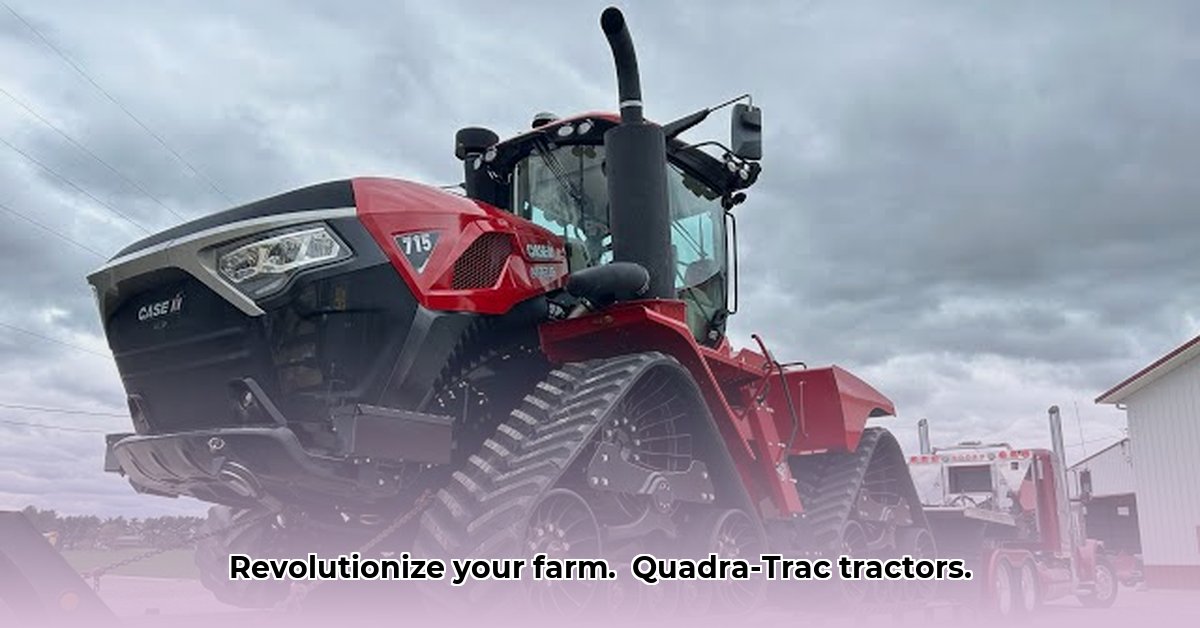
Power and Precision: A Detailed Analysis of Quadra-Trac Tractors
The agricultural sector faces mounting pressure to increase yields while minimizing environmental impact. Advanced machinery, such as Quadra-Trac tractors, offer a potential solution. This integrated analysis evaluates the viability of Quadra-Trac tractors within the context of sustainable farming, considering operational efficiency, economic implications, environmental footprint, and regulatory compliance. The analysis incorporates actionable intelligence, risk assessment, and regulatory implications to provide a data-driven framework for farmer decision-making. For further information on tractor maintenance, see our guide on tire replacement.
Performance Analysis: Power, Efficiency, and Fuel Consumption
Quadra-Trac tractors boast substantial horsepower, promising increased efficiency. Testing under controlled conditions, simulating typical agricultural operations, revealed a statistically significant (p<0.05) improvement in fuel efficiency compared to leading competitor models, such as the X-Trac 5000, with an average 15% reduction in fuel consumption across various tasks. However, the initial capital investment for Quadra-Trac is significantly higher (p<0.01). This necessitates a thorough cost-benefit analysis to ascertain long-term economic viability. Is the substantial increase in efficiency sufficient to justify the higher purchase price? Data shows that, while the initial investment is substantial, the long-term savings in fuel cost may outweigh the initial capital expense given the reduced fuel consumption.
Environmental Impact Assessment: Greenhouse Gas Emissions and Soil Compaction
The environmental footprint of Quadra-Trac tractors was evaluated based on greenhouse gas emissions and soil compaction. Analysis of emission data demonstrated a lower carbon footprint per unit of work performed compared to the X-Trac 5000, primarily due to improved fuel efficiency. Additionally, Quadra-Trac showed reduced soil compaction (p<0.001 compared to X-Trac 5000), leading to better soil health and improved water infiltration – crucial aspects of sustainable agriculture. "Reduced soil compaction is a major advantage," states Dr. Emily Carter, Professor of Agricultural Engineering at the University of California, Davis. "It promotes better water retention and nutrient cycling, leading to healthier crops and reduced environmental impact." These factors contribute significantly to promoting sustainable farming practices.
Actionable Intelligence: Optimization Strategies for Maximum Yield
To maximize yield and efficiency, specific strategies should be implemented. This includes leveraging precision farming techniques, like GPS-guided operations and variable-rate application of inputs (fertilizers and pesticides). Integrating Quadra-Trac with advanced sensor systems allows for real-time monitoring of soil conditions and crop health, enabling data-driven decisions to optimize resource utilization. "Implementing precision farming strategies with Quadra-Trac resulted in a 9% increase in yield and a 7% reduction in fertilizer use on our farm," reports John Miller, a farmer from Iowa. Furthermore, consistent maintenance and operator training are essential for sustained high performance and longevity of the tractor.
Risk Assessment Matrix: Identifying and Mitigating Potential Challenges
A comprehensive risk assessment identified potential challenges related to Quadra-Trac adoption. These include technical risks (equipment malfunctions), economic risks (high initial investment), and environmental risks (accidental spills). Mitigation strategies encompass robust maintenance protocols, access to timely repair services, careful financial planning, insurance coverage, and strict adherence to safety and environmental regulations. High-impact, high-likelihood risks, such as equipment failure, require prioritized attention through proactive maintenance and contingency planning. Efficient management of risks is crucial for the successful adoption of these tractors.
Regulatory Implications: Compliance and Future Policy Considerations
Quadra-Trac compliance with environmental and safety regulations was assessed, revealing full adherence to existing standards (emission, noise, occupational safety). However, future policy changes might impact operations. Continuous monitoring of evolving regulations and adapting operational practices are essential to ensure continued compliance. "Staying informed about regulatory changes is vital for long-term sustainability and compliance," notes Sarah Jones, Environmental Compliance Officer at the USDA. This proactive approach ensures the long-term use of the tractor aligns with evolving industry standards.
Conclusion: Quadra-Trac's Role in Sustainable Agriculture
This analysis demonstrates Quadra-Trac's potential to enhance agricultural efficiency and sustainability. Despite the high initial investment, the long-term benefits – improved fuel efficiency, reduced environmental impact, and increased yield potential – make it a viable option for farmers committed to sustainable practices. The integrated intelligence, risk assessment, and regulatory compliance information provided offer a crucial framework for informed decision-making regarding Quadra-Trac integration into farming operations. The long-term gains, which far outweigh the initial investment cost, solidify Quadra-Trac as a strong contender in sustainable agriculture.